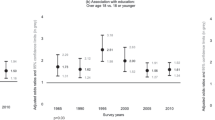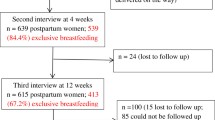Breastfeeding, in spite of proven benefits and energetic promotion, lags behind national goals, is less prevalent in disadvantaged populations, and declines across successive children in a family. Using longitudinally linked data from the New Jersey Electronic Birth Certificate (EBC) from 1996 to 2001, we found considerable fluidity in breastfeeding status at hospital discharge for births to the same mother. Among mothers who breastfed exclusively after the first birth, only 69% did so after the second (we refer to this as recurrence). Among mothers who exclusively formula fed after the first birth, 16% initiated exclusive breastfeeding after the second birth (referred to as recruitment). Combination feeding the first born, i.e., breastfeeding supplemented by formula, was followed by exclusive breastfeeding for 38% of second births. Rates of recurrence and recruitment differed in distinct ways by race/ethnicity and immigrant status. We conclude that breastfeeding initiation is not necessarily or exclusively a matter of fixed preferences, and that opportunities exist to expand breastfeeding to realize national goals by enhancing both recurrence and recruitment.




Similar content being viewed by others
Abbreviations
- WIC:
-
Special Supplemental Nutrition Program for Women, Infants, and Children
- EBC:
-
Electronic Birth Certificate.
REFERENCES
American Academy of Pediatrics, Section on Breastfeeding. Breastfeeding and the use of human milk. Pediatrics. 2005;115(2):496–506.
U.S. Department of Health and Human Services. HHS blueprint for action on breastfeeding. Washington, DC: U.S. Department of Health and Human Services, Office of Women's Health; 2000.
World Health Organization. Protecting, promoting, and supporting breastfeeding: The special role of maternity services. A joint WHO/UNICEF statement. Geneva, WHO, 1989.
American College of Obstetricians and Gynecologists. Breastfeeding: Maternal and infant aspects. ACOG Educational Bulletin No. 258. Washington, DC: ACOG, July 2000.
American Academy of Family Physicians. Breastfeeding and infant nutrition, 1994. 1998–1999 AAFP Reference Manual. Washington, DC: American Academy of Family Physicians, 1994, p. 51. http://www.aafp.org/policy/75.html.
O’Campo P, Faden RR, Gielen AC, Wang MC. Prenatal factors associated with breastfeeding duration: Recommendations for prenatal interventions. Birth. 1992;19(4):195–201.
Kloeblen AS, Thompson NJ, Miner KR. Predicting breast-feeding intention among low-income pregnant women: A comparison of two theoretical models. Health Educ Behav 1999;26(5):675–88.
Philipp BL, Merewood A, Miller LW, Chawla N, Murphy-Smith MM, Gomes JS, Cimo S, Cook JT. Baby-friendly hospital initiative improves breastfeeding initiation rates in a US hospital setting. Pediatrics 2001;108(3):677–81.
Philipp BL, Malone KL, Cimo S, Merewood A. Sustained breastfeeding rates at a US baby-friendly hospital. Pediatrics 2003;112(3 Pt 1):e234–e36.
Kruse LK, Denk CE, Feldman-Winter L, Rotondo FM. Comparing sociodemographic and hospital influences on breastfeeding initiation. Births 2005;32(2):81–85.
Donath SM, Amir LH. ALSPAC Study Team. Relationship between prenatal infant feeding intention and initiation and duration of breastfeeding: A cohort study. Acta Paediatr 2003;92(3):352–56.
Chezem JC, Friesen C, Boettcher J. Breastfeeding knowledge, breastfeeding confidence, and infant feeding plans: Effects on actual feeding practices. J Obstet Gynecol Neonatal Nurs 2003;32(1):40–47.
Taveras EM, Capra AM, Braveman PA, Jensvold NG, Escobar GJ, Lieu TA. Clinician support and psychosocial risk factors associated with breastfeeding discontinuation. Pediatrics 2003;112(1):108–15.
Sharps PW, El-Mohandes AE, El-Khorazaty MN, Kiely M, Walker T. Health beliefs and parenting attitudes influence breastfeeding patterns among low-income African–American women. J Perinatol 2003;23:414–19.
Howard CR, Howard FM, Lanphear B, Eberly S, deBlieck EA, Oakes D, Lawrence RA. Randomized clinical trial of pacifier use and bottle-feeding or cupfeeding and their effect on breastfeeding. Pediatrics. 2003;111(3):511–18.
Feldman-Winter L, Kruse L, Mulford C, Rotondo F. Breastfeeding initiation rates derived from electronic birth certificate data in New Jersey. J Human Lact. 2002;18(4);373–77.
Ryan AS, Wenjun Z, Acosta A. Breastfeeding continues to increase into the new millennium. Pediatrics. 2002;110:1103–09.
MatchWare Technologies, Inc. AUTOMATCH: Generalized Record Linkage System, Version 4.2. Kennebunkport, ME. 1998.
Tuma NB, Hannan MT. Social dynamics. Orlando: Academic Press, 1984.
SAS Software for Analysis of Statistical Data: User's Manuel, Release 7.0. Research Triangle Park, NC: Research Triangle Institute; 1996.
Pugh LC, Milligan RA, Frick KD, Spatz D, Bronner Y. Breastfeeding duration, costs, and benefits of a support program for low-income breastfeeding women. Birth 2002;29(2):95–100.
Porteous R, Kaufman K, Rush J. The effect of individualized professional support on duration of breastfeeding: A randomized controlled trial. J Hum Lact 2000;16(4):303–08.
Dennis C-L, Hodnett E, Gallop R, Chalmers B. The effect of peer support on breast-feeding duration among primiparous women: A randomized controlled trial. Canadian Med Assoc J 2002;166(1):21–28.
Bronner Y, Barber T, Vogelhut J, Resnik AK. Breastfeeding peer counseling: Results from the National WIC Survey. J Hum Lact 2001;17(2):119–25.
Guise J-M, Palda V, Westhoff C, Chan BKS, Helfand M, Lieu TA. The effectiveness of primary care-based interventions to promote breastfeeding: Systematic evidence review and meta-analysis for the US Preventive Services Task Force. Ann Fam Med 2003;1(2):70–78.
US Preventive Services Task Force. Behavioral interventions to promote breastfeeding: Recommendations and Rationale from the USPSTF. Ann Fam Med 2003;1(2):1–5. http://www.annfammed.org
Feldman-Winter L, Rotondo FM, Denk CE, Kruse LK. Breastfeeding in New Jersey, 2002. PRAMS Brief. 2004; http://www.state.nj.us/health/fhs/wic.html
Merewood A, Heinig J. Efforts to promote breastfeeding in the United States: Development of a national breastfeeding awareness campaign. J Hum Lact 2004;20(2):140–45.
Author information
Authors and Affiliations
Corresponding author
Rights and permissions
About this article
Cite this article
Kruse, L., Denk, C.E., Feldman-Winter, L. et al. Longitudinal Patterns of Breastfeeding Initiation. Matern Child Health J 10, 13–18 (2006). https://doi.org/10.1007/s10995-005-0027-1
Published:
Issue Date:
DOI: https://doi.org/10.1007/s10995-005-0027-1




